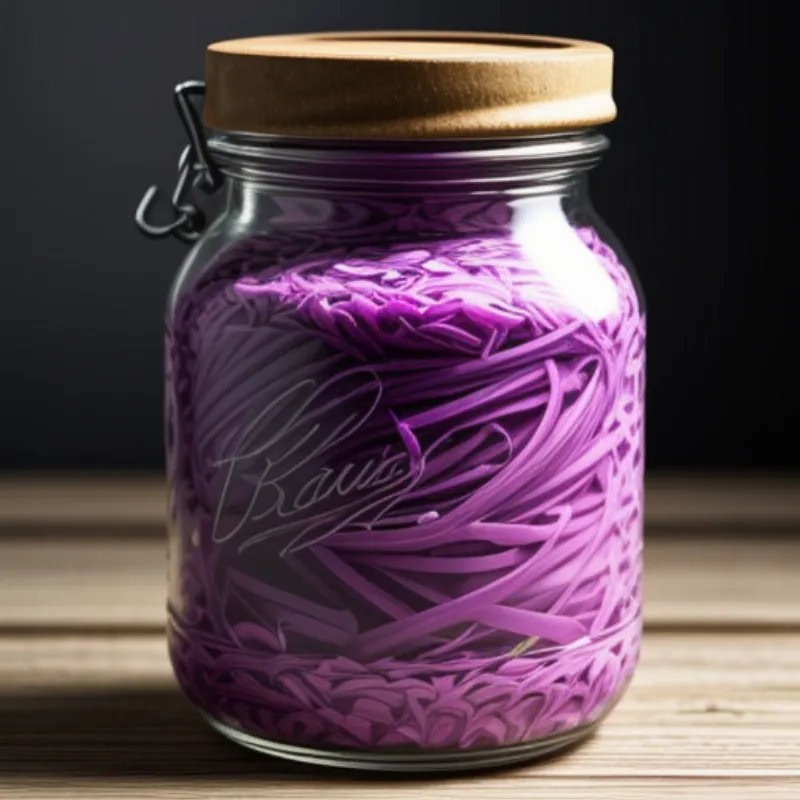Sauerkraut, a tangy and crunchy fermented cabbage, might sound intimidating to make, but it’s surprisingly simple. With just two main ingredients and a bit of patience, you can create this probiotic powerhouse in your own kitchen. Not only is sauerkraut incredibly delicious, but it’s also packed with gut-healthy bacteria that can boost your overall well-being.
Why You Should Try Making Sauerkraut
I remember the first time I tried sauerkraut; I was skeptical. Pickled cabbage? Really? But one bite and I was hooked. The tangy flavor, the satisfying crunch – it was unlike anything I’d ever tasted. Then I discovered how easy it was to make, and I’ve been hooked on fermenting ever since.
Making sauerkraut at home allows you to control the ingredients, ensuring a pure and flavorful result. Plus, it’s incredibly satisfying to see the transformation from simple cabbage to a jar of vibrant, fermented goodness.
Ingredients for Sauerkraut
- Cabbage: 1 medium head (about 2 pounds), preferably organic
- Salt: 1 1/2 – 2 tablespoons of non-iodized sea salt
Optional additions for extra flavor:
- Caraway seeds: 1 tablespoon
- Juniper berries: 1 teaspoon
- Garlic: 2 cloves, thinly sliced
- Ginger: 1 inch, peeled and grated
Equipment You’ll Need
- Large bowl: For mixing and massaging the cabbage
- Jar: A 32-ounce (or larger) glass jar with a wide mouth
- Weight: A smaller jar, a ziplock bag filled with water, or a fermentation weight to keep the cabbage submerged
- Clean cloth: To cover the jar during fermentation
Step-by-Step Sauerkraut Making Guide
1. Prepare the Cabbage
- Remove any wilted outer leaves from the cabbage.
- Rinse the cabbage thoroughly and pat it dry.
- Slice the cabbage into thin shreds using a sharp knife or a mandoline.
2. Salt and Massage the Cabbage
- Place the shredded cabbage in the large bowl and sprinkle with salt.
- Using clean hands, begin massaging the cabbage, squeezing and pressing it to release its natural juices.
- Continue massaging for about 10 minutes, or until the cabbage has softened and released a significant amount of liquid.
3. Pack the Jar
- Pack the salted cabbage tightly into the jar, pressing down firmly to remove any air pockets.
- Pour the remaining cabbage juice over the top, ensuring the liquid completely covers the cabbage. If there isn’t enough liquid, you can add a little filtered water.
4. Ferment Your Sauerkraut
- Place your chosen weight on top of the cabbage, ensuring it’s fully submerged in the brine. This prevents mold growth.
- Cover the jar with a clean cloth or towel and secure it with a rubber band.
- Store the jar in a cool, dark place (ideally around 65-75°F) for at least 3 days and up to 4 weeks.
5. Taste and Enjoy!
- After 3 days, taste your sauerkraut. If you prefer a more sour flavor, continue fermenting for longer, checking the taste every few days.
- Once you’re satisfied with the taste, transfer the jar to the refrigerator to slow down the fermentation process.
 Sauerkraut in a jar
Sauerkraut in a jar
Tips for Perfect Sauerkraut
- Salt matters: Using the right amount of salt is crucial for flavor and safe fermentation. Iodized salt can hinder the fermentation process, so stick with non-iodized sea salt.
- Don’t rush the process: Patience is key with fermentation. Allowing your sauerkraut to ferment for a longer period develops a more complex and tangy flavor.
- Experiment with flavors: Get creative and add other vegetables or spices to your sauerkraut. “My grandmother always added caraway seeds to her sauerkraut,” shares renowned fermentation expert, Michael Jones. “It adds a subtle yet delicious earthy flavor.”
- Check for bubbles: During fermentation, you’ll likely see bubbles forming in the jar – this is a good sign that the process is working!
 Delicious sauerkraut on a plate
Delicious sauerkraut on a plate
Serving and Enjoying Your Sauerkraut
Sauerkraut isn’t just a condiment; it’s a versatile ingredient that adds a punch of flavor to various dishes:
- Classic Side: Serve it alongside grilled sausages, hot dogs, or roasted meats for a traditional German treat. Speaking of sausages, have you tried our recipe for Grilled Sausages? They’re the perfect pairing for your homemade sauerkraut.
- Salads and Bowls: Add a spoonful to your salads for a tangy crunch. For a heartier meal, try incorporating it into grain bowls or Buddha bowls.
- Sandwiches: Sauerkraut is a fantastic addition to sandwiches, adding a zesty contrast to rich fillings.
- Soups and Stews: Stir a spoonful into soups and stews for an extra layer of flavor and depth.
 Sauerkraut with sausages
Sauerkraut with sausages
Sauerkraut: A World of Flavor Awaits
Making sauerkraut is a rewarding experience, connecting you to ancient culinary traditions while creating something deliciously beneficial for your health. So grab some cabbage, unleash your inner fermenter, and embark on this flavorful journey! And if you love fermented cabbage, be sure to check out our recipe for Pickled Cabbage as well. Happy fermenting!
